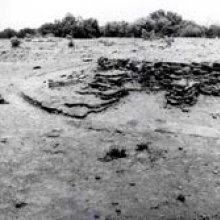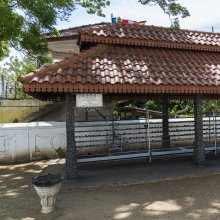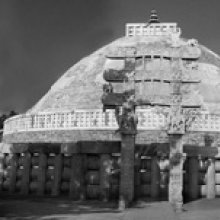Madhya, Mādhya: 36 definitions
Introduction:
Madhya means something in Buddhism, Pali, Hinduism, Sanskrit, Jainism, Prakrit, the history of ancient India, Marathi, Hindi, biology. If you want to know the exact meaning, history, etymology or English translation of this term then check out the descriptions on this page. Add your comment or reference to a book if you want to contribute to this summary article.
Alternative spellings of this word include Madhy.
Images (photo gallery)
(+8 more images available)
In Hinduism
Ayurveda (science of life)
Source: Wisdom Library: Āyurveda and botanyMadhya (मध्य, “central zone”):—One of the six types of habitats (deśa).—These geographical habitats are divided according to their bhūtas. Jāṅgala has a predominance of Vāta and Pitta. Skilled physicians should account for the nature of the habitat when treating a patient. The word is used throughout Ayurvedic (India medicine) literature such as the Caraka-saṃhitā and the Suśruta-saṃhitā.

Āyurveda (आयुर्वेद, ayurveda) is a branch of Indian science dealing with medicine, herbalism, taxology, anatomy, surgery, alchemy and related topics. Traditional practice of Āyurveda in ancient India dates back to at least the first millenium BC. Literature is commonly written in Sanskrit using various poetic metres.
Natyashastra (theatrics and dramaturgy)
Source: Wisdom Library: Nāṭya-śāstra1) Madhya (मध्य, “middle”) refers to one of the three sizes of playhouse (nāṭyamaṇḍapa) used, according to the Nāṭyaśāstra 2.8-11. This size is stated to be meant for kings (the other sizes being meant for Gods or humans). The measurement of the jyeṣṭha type playhouse is stated to count 64 hastas (also translated as ‘cubit’; one hasta equals 24 aṅgulas). They can also be measured using the same amount of daṇḍas (one daṇḍa equals 4 hastas).
2) Madhyā (मध्या) refers to a class of rhythm-type (chandas) containing three syllables in a pāda (‘foot’ or ‘quarter-verse’), according to the Nāṭyaśāstra chapter 15. There are twenty-six classes of chandas and out of them arise the various syllabic meters (vṛtta), composed of four pādas, defining the pattern of alternating light and heavy syllables.
3) Madhya (मध्य, “medium”) refers to one of the three tempos (laya) according to the Nāṭyaśāstra chapter 31. Accordingly, “the totality of syllables penultimate to the yati, will indicate the tempo, and from the tempo the measure of these will change. A decrease of kalās should be made in other pāṇis. In the slow tempo, there should be one sannipāta, in the medium tempo two sannipātas, and in the quick tempo the number of sannipātas should be four. That which is indicated by this difference, is called the quick and the medium tempo, and the avapāṇi is dependent on a medium tempo. When the tālas of one kalā become the antarakalā played in quick tempo, then it is called the uparyuparipāṇi”.
4) Madhya (मध्य) or Rajanī is the name of a meter belonging to the Vṛtta (syllabic) class of Dhruvā (songs) described in the Nāṭyaśāstra chapter 32:—“when the two syllables are short and one long in the triad of its feet, the metre is rajanī”.
Source: Shodhganga: The significance of the mūla-beras (natya)Madhya (मध्य) or Madhyanāyikā refers to an “adolescent and partly experienced heroine”, of the Svakīya type and represents one of the three kinds of “heroines” (nāyikā) in a dramatic representation, according to the Abhinaya-sara-samputa, as used within the classical tradition of Indian dance and performance, also known as Bharatanatyam.—In the depiction of any mood or sentiment, a dance performance or a dramatic representation takes the medium of the hero (nāyaka) and the heroine (nāyikā). The heroine is called svakīya when she possesses good character and is upright. She is again classified into three types [viz., Mugdha-nāyikā].
The heroine of the Madhya type is divided into three types: laghu (light annoyance or fury on seeing other women), madhya (medium indignation on hearing the name of another women), and guru (intense anger on seeing the marks of another woman’s love for her lover). There are three activities of the nāyika in this indignation: dhīra (a self-controlled heroine who greets her deceitful lover with sarcastic words), dhīradhīra (partly self-controlled heroine, who rebukes her lover in tears), and adhīra (the heroine who lacks self-control and scolds her lover harshly).

Natyashastra (नाट्यशास्त्र, nāṭyaśāstra) refers to both the ancient Indian tradition (shastra) of performing arts, (natya—theatrics, drama, dance, music), as well as the name of a Sanskrit work dealing with these subjects. It also teaches the rules for composing Dramatic plays (nataka), construction and performance of Theater, and Poetic works (kavya).
Purana and Itihasa (epic history)
Source: archive.org: Shiva Purana - English TranslationMadhya (मध्य) refers to the “waist” (lit. “midsection”) and is used to describe Pārvatī, according to the Śivapurāṇa 2.3.12.—Accordingly, after Himācala (i.e., Himālaya) brought his daughter (Pārvatī) before Śiva: “Then Śiva looked at her in the first flush of her youth. [...] Her two breasts resembling lotus-buds were stout, plump and firm. Her waist was slender [i.e., kṣīṇa-madhyā] and the curly locks of her hair shone well. Her feet resembled the land-lotus and were comely in appearance. She was competent to shake the minds of even the sages deeply engrossed in meditation, even at the very sight. She was a crest-jewel of all the maidens in the world”.
Source: Cologne Digital Sanskrit Dictionaries: The Purana Index1a) Madhya (मध्य).—A Gandharva.*
- * Brahmāṇḍa-purāṇa III. 7. 11.
1b) 1000 crores × prayutam (ayuṭam-vā. p.).*
- * Brahmāṇḍa-purāṇa IV. 2. 98 and 102; Vāyu-purāṇa 101. 98.

The Purana (पुराण, purāṇas) refers to Sanskrit literature preserving ancient India’s vast cultural history, including historical legends, religious ceremonies, various arts and sciences. The eighteen mahapuranas total over 400,000 shlokas (metrical couplets) and date to at least several centuries BCE.
Shilpashastra (iconography)
Source: archive.org: Illustrations of Indian Music and Dance in Western Indian StyleMadhya (मध्य, “medium”).—Illustration of madhya-grāma (mediocre group of tones) according to 15th century art.—The colour of the body of madhya-grāma is golden-yellow. He holds a vīṇā (Indian lute) with both hands. The colour of the scarf is rosy with red dots and the lower garment is green with a black design. He is well-dressed and tastefully ornamented.
The illustrations (of, for example Madhya) are found scattered throughout ancient Jain manuscripts from Gujarat. The descriptions of these illustrations of this citrāvalī are based on the ślokas of Vācanācārya Gaṇi Sudhākalaśa’s Saṅgītopaniṣatsāroddhāra (14th century) and Śārṅgadeva’s Saṅgītaratnākara (13th century).

Shilpashastra (शिल्पशास्त्र, śilpaśāstra) represents the ancient Indian science (shastra) of creative arts (shilpa) such as sculpture, iconography and painting. Closely related to Vastushastra (architecture), they often share the same literature.
Vyakarana (Sanskrit grammar)
Source: Wikisource: A dictionary of Sanskrit grammarMadhya (मध्य).—lit. middle; middling variety. The word is used in the sense of the middling effort between the open (विवृत (vivṛta)) and the close (संवृत (saṃvṛta)) external efforts which technically is called हकार (hakāra); cf. मध्ये हकारः । मध्ये भवः मध्यः । अ सांप्रतिके । तदयमर्थः । सांप्रतिके प्रकृतिस्थे कण्ठे सति हकारो नाम बाह्यः प्रयत्नः क्रियते । तेन च व्यञ्जनेषु घोषो जायते । (madhye hakāraḥ | madhye bhavaḥ madhyaḥ | a sāṃpratike | tadayamarthaḥ | sāṃpratike prakṛtisthe kaṇṭhe sati hakāro nāma bāhyaḥ prayatnaḥ kriyate | tena ca vyañjaneṣu ghoṣo jāyate |) T. Pr. Bhāṣya on II.6.

Vyakarana (व्याकरण, vyākaraṇa) refers to Sanskrit grammar and represents one of the six additional sciences (vedanga) to be studied along with the Vedas. Vyakarana concerns itself with the rules of Sanskrit grammar and linguistic analysis in order to establish the correct context of words and sentences.
Chandas (prosody, study of Sanskrit metres)
Source: Shodhganga: a concise history of Sanskrit Chanda literatureMadhyā (मध्या) is one of the twenty-six varieties of Sanskrit metres (chandas) mentioned in the Chandaśśāstra 1.15-19. There are 26 Vedic metres starting with 1 to 26 letters in each pāda. It is a common belief that the classical metres are developed from these 26 metres. Generally a metre has a specific name according to it’s number of syllables (akṣara). But sometimes the same stanza is called by the name of another metre from the point of view of the pādas.

Chandas (छन्दस्) refers to Sanskrit prosody and represents one of the six Vedangas (auxiliary disciplines belonging to the study of the Vedas). The science of prosody (chandas-shastra) focusses on the study of the poetic meters such as the commonly known twenty-six metres mentioned by Pingalas.
Jyotisha (astronomy and astrology)
Source: Wisdom Library: Brihat Samhita by VarahamihiraMadhya (मध्य) refers to a “moderate” [?] (condition of the world), according to the Bṛhatsaṃhitā (chapter 9), an encyclopedic Sanskrit work written by Varāhamihira mainly focusing on the science of ancient Indian astronomy astronomy (Jyotiṣa).—Accordingly, “If Venus (śukra) should either disappear or reappear in a northern Vīthi there will be prosperity and happiness in the land; if in a central Vīthi there will not be much of either; and if in a southern Vīthi mankind will be afflicted with miseries. If Venus should disappear or reappear in the several Vīthis beginning from the northernmost one, the condition of the world will respectively be—1. Very excellent, 2. Excellent, 3. Good. 4. Fair, 5. Moderate [i.e., madhya], 6. Tolerable, 7. Poor, 8. Very poor, 9. Miserable”.
Source: Wikibooks (hi): Sanskrit Technical TermsMadhya (मध्य).—1. Centre, middle. 2. Mean. 3. Middle term in a series. 4. Zenith distance of ecliptic point. Note: Madhya is a Sanskrit technical term used in ancient Indian sciences such as Astronomy, Mathematics and Geometry.

Jyotisha (ज्योतिष, jyotiṣa or jyotish) refers to ‘astronomy’ or “Vedic astrology” and represents the fifth of the six Vedangas (additional sciences to be studied along with the Vedas). Jyotisha concerns itself with the study and prediction of the movements of celestial bodies, in order to calculate the auspicious time for rituals and ceremonies.
Shaktism (Shakta philosophy)
Source: Google Books: ManthanabhairavatantramMadhyā (मध्या) refers to one of the thirty-two Bhairavīs (also Dūtis) embodying the syllables of the goddess’s Vidyā, according to the Manthānabhairavatantra, a vast sprawling work that belongs to a corpus of Tantric texts concerned with the worship of the goddess Kubjikā.—The thirty-two Bhairavīs [i.e., Madhyā] are the consorts of the Bhairavas presiding over the sonic energies of the thirty-two syllables of her Vidyā. [...] Notice that like there are Yoginīs in this group who are also worshipped independently as the Great Goddess. Moreover, several also appear in other groups.

Shakta (शाक्त, śākta) or Shaktism (śāktism) represents a tradition of Hinduism where the Goddess (Devi) is revered and worshipped. Shakta literature includes a range of scriptures, including various Agamas and Tantras, although its roots may be traced back to the Vedas.
Shaivism (Shaiva philosophy)
Source: Brill: Śaivism and the Tantric TraditionsMadhya (मध्य) refers to “four middling (siddhis), according to the Kiraṇatantra chapter 49 (dealing with vratacaryā).—Accordingly, “Garuḍa spoke: ‘You have taught me, O great Lord, the activities of the Neophyte, the Putraka and the Ācārya. Tell me those of the Sādhaka’. The Lord spoke: ‘[...] This is the auspicious Raudra-vrata: imposing with a chignon of matted locks, marked by a trident and khaṭvāṅga, equipped with a clean half skull, awe-inspiring with a third eye, clothed in the skin of a tiger, peaceful. For one firm [in this observance, the highest Siddhi will arise in six months]; middling (madhya-siddhi) [powers] in four months; the lowest [powers] will arise in three months. [...]’”.

Shaiva (शैव, śaiva) or Shaivism (śaivism) represents a tradition of Hinduism worshiping Shiva as the supreme being. Closely related to Shaktism, Shaiva literature includes a range of scriptures, including Tantras, while the root of this tradition may be traced back to the ancient Vedas.
Vastushastra (architecture)
Source: Brill: Śaivism and the Tantric Traditions (architecture)Madhya (मध्य) refers to the “centre (of the house)”, according to the Devyāmata (verse 105.22).—Accordingly, “[...] the water supply should be in the centre of the house (gṛha-madhya). [...]”

Vastushastra (वास्तुशास्त्र, vāstuśāstra) refers to the ancient Indian science (shastra) of architecture (vastu), dealing with topics such architecture, sculpture, town-building, fort building and various other constructions. Vastu also deals with the philosophy of the architectural relation with the cosmic universe.
Ganitashastra (Mathematics and Algebra)
Source: archive.org: Hindu Mathematics1) Madhya (मध्य) refers to “ten-billion” (10,000,000,000) in various lists of numeral denominations, according to gaṇita (“science of calculation”) and Gaṇita-śāstra, ancient Indian mathematics and astronomy.—We can definitely say that from the very earliest known times, ten has formed the basis of numeration in India. While the Greeks had no terminology for denominations above the myriad (104), and the Romans above the milk (103), the ancient Hindus dealt freely with no less than eighteen denominations [e.g., madhya]. Cf. Yajurveda-saṃhitā (Vājasanyī) XVII.2; Taittirīya-saṃhitā IV.40.11, VII.2.20.1; Maitrāyaṇī-saṃhitā II.8.14; Kāṭhaka-saṃhitā XVII.10, XXXIX.6; Anuyogadvāra-sūtra 142; Āryabhaṭīya II.2; Gaṇitasārasaṃgraha I.63-68.
2) Madhya (मध्य) also refers to “ten quadrillion” (10,000,000,000,000,000) according to Śrīdhara in the Triśatikā.

Ganitashastra (शिल्पशास्त्र, gaṇitaśāstra) refers to the ancient Indian science of mathematics, algebra, number theory, arithmetic, etc. Closely allied with astronomy, both were commonly taught and studied in universities, even since the 1st millennium BCE. Ganita-shastra also includes ritualistic math-books such as the Shulba-sutras.
Gitashastra (science of music)
Source: Shodhganga: Elements of Art and Architecture in the Trtiyakhanda of the Visnudharmottarapurana (gita)Madhya (मध्य) refers to a “medium pitch” (in music), according to the Viṣṇudharmottarapurāṇa, an ancient Sanskrit text which (being encyclopedic in nature) deals with a variety of cultural topics such as arts, architecture, music, grammar and astronomy.—In Indian Music, the word saptaka is used to denote the scale or octave of Music. Actually the scale of seven notes is called as saptaka. According to the Viṣṇudharmottarapurāṇa, three kinds of scales or octaves viz., mandra i.e., low pitch, madhya i.e., medium pitch and tāra i.e., high pitch are there in Music and these three kinds of octaves occur from the three respective sthānas viz., chest, throat and head. The mandra-saptaka is basically the amalgamation of low notes which come out from the deep of the heart. The madhya i.e., medium notes come from the throat and the tāra i.e., high notes come from the head. To practise classical Music, the singers are generally seen to adopt the madhya-saptaka i.e., middle scale.
Gitashastra (गीतशास्त्र, gītaśāstra) refers to the ancient Indian science of Music (gita or samgita), which is traditionally divided in Vocal music, Instrumental music and Dance (under the jurisdiction of music). The different elements and technical terms are explained in a wide range of (often Sanskrit) literature.
Sports, Arts and Entertainment (wordly enjoyments)
Source: archive.org: Syainika Sastra of Rudradeva with English Translation (art)Madhya (मध्य) refers to the “middle” (of a hunting party), according to the Śyainika-śāstra: a Sanskrit treatise dealing with the divisions and benefits of Hunting and Hawking, written by Rājā Rudradeva (or Candradeva) in possibly the 13th century.—Accordingly, [while discussing the outlines of hawking]: “[...] At the middle (madhya) of the party there should be the leading hawker, with two soldiers on each side. The circle should be made with twenty-one horsemen. All men in the circle, with their eyes fixed on the chief hawker, should remain at a distance of four cubits from each other, in two equal divisions on each side. [...]”.

This section covers the skills and profiencies of the Kalas (“performing arts”) and Shastras (“sciences”) involving ancient Indian traditions of sports, games, arts, entertainment, love-making and other means of wordly enjoyments. Traditionally these topics were dealt with in Sanskrit treatises explaing the philosophy and the justification of enjoying the pleasures of the senses.
In Buddhism
Mahayana (major branch of Buddhism)
Source: academia.edu: A Study and Translation of the Gaganagañjaparipṛcchā1) Madhya (मध्य) refers to the “middle”, according to the Gaganagañjaparipṛcchā: the eighth chapter of the Mahāsaṃnipāta (a collection of Mahāyāna Buddhist Sūtras).—Accordingly, “[...] The Bodhisattva Gaganagañja then sustained the jewel-canopy of ten thousand yojanas high over the Lord’s lion throne in the sky, joined the palms of his hands, saluted, and praised the Lord with these suitable verses: ‘[...] (9) Without discrimination (vikalpa) eliminating the middle (madhya) and the extremes (anta), [you understand] emptiness that all has a trifling intrinsic nature, is worthless and void. Though, knowing the complete purity of such dharmas, you explain cause and action to living beings. [...]”.
2) Madhya (मध्य) refers to the “middling” kind of discrimination, according to the Gaganagañjaparipṛcchā: the eighth chapter of the Mahāsaṃnipāta (a collection of Mahāyāna Buddhist Sūtras).—Accordingly, “Then, the Lord went on to speak these verses: ‘(35) Giving a gift with the same thought (samacitta) and same mind (samamanas), they give without the three [kinds of discrimination of] superior, mediocre, and inferior (hīna-madhya-viśiṣṭa). Since their intentions (āśaya) are pure and undefiled, they do not expect any reward (vipāka). [...]’”.

Mahayana (महायान, mahāyāna) is a major branch of Buddhism focusing on the path of a Bodhisattva (spiritual aspirants/ enlightened beings). Extant literature is vast and primarely composed in the Sanskrit language. There are many sūtras of which some of the earliest are the various Prajñāpāramitā sūtras.
Tibetan Buddhism (Vajrayana or tantric Buddhism)
Source: MDPI Books: The Ocean of HeroesMadhya (मध्य) refers to the “center (of a village)”, according to the 10th-century Ḍākārṇava-tantra: one of the last Tibetan Tantric scriptures belonging to the Buddhist Saṃvara tradition consisting of 51 chapters.—Accordingly: “Now, [the Blessed One] has taught [holy sites] such as the pīṭha and upapīṭha in sequence. [...] (7) The melāpaka [sites] are proclaimed to be a bank of a river, a garden, an ocean, and a place where four roads meet. (8) The upamelāpaka [sites] are on the summit of a mountain, the center of a village (grāma-madhya), and Vṛndākaumāriparvaka (or a mountain [where there is] a flock of maidens). A lineage land is [also] the upamelāpaka. [...]”.

Tibetan Buddhism includes schools such as Nyingma, Kadampa, Kagyu and Gelug. Their primary canon of literature is divided in two broad categories: The Kangyur, which consists of Buddha’s words, and the Tengyur, which includes commentaries from various sources. Esotericism and tantra techniques (vajrayāna) are collected indepently.
General definition (in Buddhism)
Source: Wisdom Library: BuddhismMadhya (मध्य, “hundred-million”) is the ninth of sixty digits (decimal place) in an special enumeration system mentioned by Vasubandhu in his Abhidharmakośa (“treasury of knowledge”). The explanations of the measure of years, eons, and so forth must be comprehended through calculation based on a numerical system. Enumeration begins from one and increases by a factor of ten for each shift in decimal place. The sixtieth number in this series is called “countless”.
Among these decimal positions (e.g., madhya, “hundred-million”), the first nine positions from one to one hundred million are called ‘single set enumeration’. From a billion up to, but not including countless is “the enumeration of the great companion” and is called the ‘recurring enumeration’.
In Jainism
General definition (in Jainism)
Source: The University of Sydney: A study of the Twelve ReflectionsMadhya (मध्य) refers to “inside” (a particular hell), according to the 11th century Jñānārṇava, a treatise on Jain Yoga in roughly 2200 Sanskrit verses composed by Śubhacandra.—Accordingly, “They fall from that place [and] immediately they enter the Rasātala hell. They roam about the whole world like the wind [and] they fall down into the Naraka hell.—[com.—Having created (kṛtvā) the bondage of karma fit for hell (narakaprāyogyakarmabandhaṃ), they go (gacchanti) into the Naraka hell (narakamadhye)—such is the meaning]”.
Synonyms: Udara.

Jainism is an Indian religion of Dharma whose doctrine revolves around harmlessness (ahimsa) towards every living being. The two major branches (Digambara and Svetambara) of Jainism stimulate self-control (or, shramana, ‘self-reliance’) and spiritual development through a path of peace for the soul to progess to the ultimate goal.
India history and geography
Source: Cologne Digital Sanskrit Dictionaries: Indian Epigraphical GlossaryMadhya.—(CII 1), middle course. Note: madhya is defined in the “Indian epigraphical glossary” as it can be found on ancient inscriptions commonly written in Sanskrit, Prakrit or Dravidian languages.

The history of India traces the identification of countries, villages, towns and other regions of India, as well as mythology, zoology, royal dynasties, rulers, tribes, local festivities and traditions and regional languages. Ancient India enjoyed religious freedom and encourages the path of Dharma, a concept common to Buddhism, Hinduism, and Jainism.
Biology (plants and animals)
Source: Google Books: CRC World Dictionary (Regional names)Madhya in India is the name of a plant defined with Jasminum multiflorum in various botanical sources. This page contains potential references in Ayurveda, modern medicine, and other folk traditions or local practices It has the synonym Nyctanthes pubescens Retz. (among others).
Example references for further research on medicinal uses or toxicity (see latin names for full list):
· Gard. Chron. (1881)
· A Numerical List of Dried Specimens (2874)
· Bijdr. Fl. Ned. Ind. (1826)
· Species Plantarum. (1798)
· Kew Bulletin (1984)
· Blumea (1950)
If you are looking for specific details regarding Madhya, for example chemical composition, pregnancy safety, extract dosage, diet and recipes, side effects, health benefits, have a look at these references.

This sections includes definitions from the five kingdoms of living things: Animals, Plants, Fungi, Protists and Monera. It will include both the official binomial nomenclature (scientific names usually in Latin) as well as regional spellings and variants.
Languages of India and abroad
Marathi-English dictionary
Source: DDSA: The Molesworth Marathi and English Dictionarymadhya (मध्य).—m (S) Middle or centre. 2 The waist. 3 In comp. Middle, centrical, intermediate.
Source: DDSA: The Aryabhusan school dictionary, Marathi-Englishmadhya (मध्य).—m Centre. The waist. In comp. Middle.
Marathi is an Indo-European language having over 70 million native speakers people in (predominantly) Maharashtra India. Marathi, like many other Indo-Aryan languages, evolved from early forms of Prakrit, which itself is a subset of Sanskrit, one of the most ancient languages of the world.
Sanskrit dictionary
Source: DDSA: The practical Sanskrit-English dictionaryMadhya (मध्य).—a. [man-yat nasya dhaḥ Tv.]
1) Middle, central, being in the middle or centre; एकं मुक्तागुणमिव भुवः स्थूल- मध्येन्द्रनीलम् (ekaṃ muktāguṇamiva bhuvaḥ sthūla- madhyendranīlam) Meghadūta 48; Manusmṛti 2.21.
2) Intervening, intermediate.
3) Middling, moderate, of a middling size or quality, mediocre; अग्र्यो मध्यो जघन्यश्च तं प्रवेक्ष्याम्यशेषतः (agryo madhyo jaghanyaśca taṃ pravekṣyāmyaśeṣataḥ) Manusmṛti 12.3; प्रारभ्य विघ्नविहता विरमन्ति मध्याः (prārabhya vighnavihatā viramanti madhyāḥ) Bhartṛhari 2.27.
4) Neutral, impartial.
5) Just, right.
6) Mean (in astr.).
-dhyaḥ, -dhyam 1 The middle, centre, middle or central part; अह्नः मध्यम् (ahnaḥ madhyam) midday; सहस्रदीधितिरलंकरोति मध्यमह्नः (sahasradīdhitiralaṃkaroti madhyamahnaḥ) Māl.
1) 'the sun is on the meridian' or 'right over-head'; सरति सहसा बाह्वोर्मध्यं गताप्यबला सती (sarati sahasā bāhvormadhyaṃ gatāpyabalā satī) M.4.11 (v. l.); व्योममध्ये (vyomamadhye) V.2.1.
2) The middle of the body, the waist; मध्ये क्षामा (madhye kṣāmā) Meghadūta 84; वेदिविलग्नमध्या (vedivilagnamadhyā) Kumārasambhava 1.39; विशाल- वक्षास्तनुवृत्तमध्यः (viśāla- vakṣāstanuvṛttamadhyaḥ) R.6.32; दधाना बलिभं मध्यं कर्णजाहविलोचना (dadhānā balibhaṃ madhyaṃ karṇajāhavilocanā) Bhaṭṭikāvya 4.16.
3) The belly, abdomen; मध्येन (madhyena) ... वलित्रयं चारु बभार बाला (valitrayaṃ cāru babhāra bālā) Kumārasambhava 1.39.
4) The inside or interior of anything.
5) A middle state or condition.
6) The flank of a horse.
7) Mean time in music.
8) The middle term of a progression.
9) Cessation, pause, interval.
-dhyā 1 The middle finger.
2) A young woman, one arrived at puberty.
-dhyam Ten thousand billions. [The acc., instr., abl. and loc. singulars of मध्य (madhya) are used adverbially. (a) मध्यम् (madhyam) into the midst of, into. (b) मध्येन (madhyena) through or between. (c) मध्यात् (madhyāt) out of, from among, from the midst (with gen.); तेषां मध्यात् काकः प्रोवाच (teṣāṃ madhyāt kākaḥ provāca) Pañcatantra (Bombay) 1. (d) मध्ये (madhye)
1) in the middle, between, among, in the midst; स जहार तयोर्मध्ये मैथिलीं लोकशोषणः (sa jahāra tayormadhye maithilīṃ lokaśoṣaṇaḥ) R.12.29.
2) in, into, within, inside, oft. as the first member of adverbial compounds; e. g. मध्येगङ्गम् (madhyegaṅgam) into the Ganges; मध्येजठरम् (madhyejaṭharam) in the belly; Bv.1.61; मध्येनगरम् (madhyenagaram) inside the city; मध्येनदि (madhyenadi) in the middle of the river; मध्येपृष्ठम् (madhyepṛṣṭham) on the back; मध्येभक्तम् (madhyebhaktam) a medicine taken in the middle of one's meals; मध्येरणम् (madhyeraṇam) in the battle; Bv.1.128; मध्ये- सभम् (madhye- sabham) in or before an assembly; N.6.76; मध्येसमुद्रम् (madhyesamudram) in the midst of the sea; Śiśupālavadha 3.33.].
--- OR ---
Mādhya (माध्य).—a. [madhya-aṇ] Central, middle.
Source: Cologne Digital Sanskrit Dictionaries: Edgerton Buddhist Hybrid Sanskrit DictionaryMadhya (मध्य).—adj., seems to be used (as rarely in Sanskrit) in the sense of Sanskrit madhyama, madhyastha, neutral, impartial; here perhaps more specifically umpire: tatra bhavantehi madhyehi bhavitavyaṃ Mahāvastu iii.390.14, there (where the speaker is to engage in a debate with another person) your worships must be umpires (less likely, must be present, in the midst).
Source: Cologne Digital Sanskrit Dictionaries: Shabda-Sagara Sanskrit-English DictionaryMadhya (मध्य).—mfn.
(-dhyaḥ-dhyā-dhyaṃ) 1. Middle, intermediate. 2. Right, proper, reasonable. 3. Low, vile. 4. Amongst, amidst. 5. Mean, middle, (in astronomy,) as madhyacchāyā middle or mean shadow. mn.
(-dhyaḥ-dhyaṃ) 1. The interior. 2. Mean or common time in music. 3. The middle, the centre. 4. The waist. 5. The belly, abdomen. 6. Pause, internal. 7. The middle term of a progression. f.
(-dhyā) 1. A young woman, a girl arrived at puberty. 2. The middle-finger. 3. A form of metre, a stanza of four lines containing three syllables in each. 4. Of a middle size or quantity, moderate. 5. Neutral. 6. Just, reasonable. m.
(-dhyaḥ) Cessation, rest, interval. n.
(-dhyaṃ) 1. A very large number, ten thousand billions. 2. A horse’s flank. E. mā beauty, yā to have, aṇ aff., deriv. irr., or properly san-yat aff. and dha substituted for the final.
--- OR ---
Mādhya (माध्य).—mfn.
(-dhyaḥ-dhyā-dhyaṃ) Middle, mid, (day.) E. madhya and aṇ added.
Source: Cologne Digital Sanskrit Dictionaries: Benfey Sanskrit-English DictionaryMadhya (मध्य).—[ma + dhya] (ma is an old pronoun), I. adj. 1. Middle, [Rājataraṅgiṇī] 5, 313. 2. Middle-sized, [Mānavadharmaśāstra] 8, 134; of middle sort, [Bhartṛhari, (ed. Bohlen.)] 2, 73. 3. Intermediate; amongst. 4. Right, proper. 5. Low. Ii. m. and n. 1. The middle, [Vikramorvaśī, (ed. Bollensen.)] [distich] 6; the centre, abl. amongst, [Pañcatantra] 253, 14; at the end of comp. In, [Pañcatantra] 10, 5 (nagara -madhya + m, in the town). 2. The waist. Vikr [distich] 129. Iii. m. Cessation, interval. Iv. f. yā. 1. A young woman, a girl arrived at puberty. 2. The middle finger. V. n. 1. A horse’s flank. 2. A very large number.
--- OR ---
Mādhya (माध्य).—i. e. madhya + a, adj., f. yā, and mādhyama mādhyama, i. e. madhyama + a, adj., f. mī, Middle.
Source: Cologne Digital Sanskrit Dictionaries: Cappeller Sanskrit-English DictionaryMadhya (मध्य).—[adjective] middle, central, moderate, indifferent, neutral; [neuter] (also madhye) [adverb] in the midst of, inside, in or into, between, among ([genetive] or —°, madhye also °— in [adverb]), as subst. the middle, centre, interior, [especially] the middle of the body, the waist (also [masculine]).
--- OR ---
Madhyā (मध्या).—([instrumental] adv) in the midst ([genetive]), mean-while.
--- OR ---
Mādhya (माध्य).—[adjective] middle, central.
Source: Cologne Digital Sanskrit Dictionaries: Monier-Williams Sanskrit-English Dictionary1) Madhya (मध्य):—mf(ā)n. middle (used like medius e.g. madhye samudre, ‘in the midst of the sea’), [Ṛg-veda; Vājasaneyi-saṃhitā-prātiśākhya; Kaṭha-upaniṣad]
2) middlemost, intermediate, central, [Varāha-mihira; Meghadūta]
3) standing between two, impartial, neutral, [Kāmandakīya-nītisāra]
4) middle id est. being of a middle kind or size or quality, middling, moderate (with vṛtti f. ‘a middle course’), [Lāṭyāyana; Manu-smṛti; Suśruta] etc.
5) (in [astronomy]) mean id est. theoretical (opp. to spaṣṭa, or sphuṭa), [Sūryasiddhānta] (-tva n.)
6) lowest, worst, [cf. Lexicographers, esp. such as amarasiṃha, halāyudha, hemacandra, etc.]
7) mn. (ifc. f(ā). ) the middle of the body, ([especially]) a woman’s waist, [Śatapatha-brāhmaṇa] etc. etc.
8) m. (in [algebra]) the middle term or the mean of progression, [Colebrooke]
9) Madhyā (मध्या):—[from madhya] a f. a young woman, a girl arrived at puberty, [Sāhitya-darpaṇa]
10) [v.s. ...] the middle finger, [cf. Lexicographers, esp. such as amarasiṃha, halāyudha, hemacandra, etc.]
11) [v.s. ...] (in music) a [particular] tone, [Saṃgīta-sārasaṃgraha]
12) [v.s. ...] (also n.) a kind of metre, [Colebrooke]
13) Madhya (मध्य):—n. (m. [gana] ardharcādi) the middle, midst, centre, inside, interior, [Ṛg-veda] etc. etc. (am ind. into the midst of, into, among, with [genitive case] or ifc. [Mahābhārata; Kāvya literature] etc.; dhyena ind. in or through the midst of, on the inside, through, between, with [genitive case] [accusative] or ifc. [Śatapatha-brāhmaṇa; Mahābhārata] etc.; dhyāt ind. from the midst of, out of, from among, [Rāmāyaṇa; Harivaṃśa] etc.; dhye ind. See sub voce)
14) n. the middle of the sky (with or [scilicet] nabhasas), [Manu-smṛti; Mahābhārata]
15) space between (e.g. bhruvos, the eye brows), [Mahābhārata]
16) midday (with ahnaḥ), [Mālavikāgnimitra]
17) the meridian, [Mālatīmādhava]
18) intermediate condition between ([genitive case]), [Rāmāyaṇa]
19) the belly, abdomen, [Kumāra-sambhava]
20) the flank of a horse, [cf. Lexicographers, esp. such as amarasiṃha, halāyudha, hemacandra, etc.]
21) (in music) mean time, [Saṃgīta-sārasaṃgraha]
22) ten thousand billions, [Mahābhārata]
23) cessation, pause, interval, [cf. Lexicographers, esp. such as amarasiṃha, halāyudha, hemacandra, etc.]
24) Name of a country between Sindh and Hindūstan proper, [Catalogue(s)]
25) cf. [Zend] maidhya; [Greek] μέσσος, μέσος for μέθιος; [Latin] medius; [Gothic] midjiṡ; [English] mid in midland, midnight etc.
26) Madhyā (मध्या):—[from madhya] b ind. in the middle, between, among ([genitive case]), [Ṛg-veda i, 89, 9 etc.]
27) [v.s. ...] meanwhile, [ib. x, 61, 6.]
28) Mādhya (माध्य):—mfn. ([from] madhya, of which it is also the Vṛddhi form in [compound]) middle, central, mid, [Taittirīya-saṃhitā]
Source: Cologne Digital Sanskrit Dictionaries: Yates Sanskrit-English Dictionary1) Madhya (मध्य):—[(dhyaḥ-dhyā-dhyaṃ) a.] Middle; mean; right. m. n. The west; the waist; the centre. m. Rest. f. Young woman; middle finger. n. A large number; horse’s flank.
2) Mādhya (माध्य):—[(dhyaḥ-dhyā-dhyaṃ) a.] Middle, mid(day).
Source: DDSA: Paia-sadda-mahannavo; a comprehensive Prakrit Hindi dictionary (S)Madhya (मध्य) in the Sanskrit language is related to the Prakrit word: Majjha.
[Sanskrit to German]
Sanskrit, also spelled संस्कृतम् (saṃskṛtam), is an ancient language of India commonly seen as the grandmother of the Indo-European language family (even English!). Closely allied with Prakrit and Pali, Sanskrit is more exhaustive in both grammar and terms and has the most extensive collection of literature in the world, greatly surpassing its sister-languages Greek and Latin.
Hindi dictionary
Source: DDSA: A practical Hindi-English dictionary1) Madhya (मध्य) [Also spelled madhy]:—(a) middle, central, mid-; (nm) middle; centre; the middle part or religion; ~[kāla] mediaeval period; ~[kālīna] mediaeval; ~[kālīnatā] mediaevalism; ~[tā] the middle position of a thing; ~[deśa] an ancient nomenclature for the mid-region of the country lying between the Vindhyachal, Kurukshetra and Allahabad; midland; -[paṃkti] middle row; ~[pada] means; the term situated in between; ~[pūrva] middleeast; pre-middle; ~[pradeśa] one of the Hindi speaking Indian states situated in the middle parts of the country adjoining Uttar Pradesh, Rajasthan and Maharashtra; midland; -[bhāga] centre; core; mid-region; ~[māna] mean; ~[mārga] middle course, moderate course; ~[mārgī] centrist, steering the middle course; ~[yuga] the middle ages; •[saṃbaṃdhī] mediaeval; ~[yugī] (person etc.) belonging to or characteristic of the mediaeval times; mediaeval; ~[yugīna] mediaeval; belonging to or characteristic of mediaeval times; ~[yugīnatā] mediaevalism; ~[rātri] midnight, dead of night; ~[loka] the earth, this world; ~[vaya] of middle age; ~[varga] middle class; ~[vargīya] belonging to or characteristic of the middle class, bourgeois; ~[vargīyatā] characteristics of the middle class/bourgeoisle; ~[vartī] central; intermediary, medial, intermediate; ~[vitta] bourgeois.
2) Mādhya (माध्य) [Also spelled madhy]:—(a) mean; medium; intermediate, middle; (nm) mean value; ~[māna] mean value.
...
Kannada-English dictionary
Source: Alar: Kannada-English corpusMadhya (ಮಧ್ಯ):—
1) [adjective] placed or being halfway between two given points in place or time; equidistant from all sides, points, etc.; middle; mean.
2) [adjective] of quality that is neither too good nor too bad; of intermediate quality.
3) [adjective] not having a mental leaning, inclination or preference; not partial; unbiased.
4) [adjective] fair; just and honest; free from discrimination.
--- OR ---
Madhya (ಮಧ್ಯ):—
1) [noun] the central portion or place.
2) [noun] the intermediate time.
3) [noun] the part of the body between the ribs and the hips; the waist.
4) [noun] a position or placement that is neither too good nor too bad.
5) [noun] (mus.) the medium pace or tempo.
6) [noun] (mus.) the normal octave.
7) [noun] a huge number, ten thousand billion.
--- OR ---
Madhya (ಮಧ್ಯ):—
1) [adverb] in an intermediate space, position; between.
2) [adverb] in an intermediate time; between.
Kannada is a Dravidian language (as opposed to the Indo-European language family) mainly spoken in the southwestern region of India.
See also (Relevant definitions)
Starts with (+383): Madhya-din, Madhya-divasa, Madhya-kurma, Madhya-mastishka, Madhya-svaragama, Madhya-svaralopa, Madhya-vyanjanagama, Madhyaahna-mallige, Madhyaana mallige, Madhyaanamallige, Madhyabha, Madhyabhaga, Madhyabhakta, Madhyabhangasthi, Madhyabhava, Madhyabhukti, Madhyabindu, Madhyacarin, Madhyacarya, Madhyacharin.
Ends with (+121): Abhimadhya, Abjamadhya, Agnimadhya, Amadhya, Amritamadhya, Analamadhya, Anantamadhya, Anilamadhya, Anumadhya, Aramamadhya, Arnavamadhya, Atmamadhya, Avanimadhya, Bahumadhya, Bahuramadhya, Bhavanamadhya, Bhavanmadhya, Bhrumadhya, Bhujamadhya, Bhumadhya.
Full-text (+836): Madhyama, Madhyaga, Madhyastha, Kshinamadhya, Madhyaloka, Ksharamadhya, Tanumadhya, Madhyamdinasamhita, Drutamadhya, Madhyadina, Madhyavarsha, Madhyam, Madhyamdinaranyakavyakhya, Madhyamdinagrihya, Madhyamdinasamdhyaprayoga, Madhyamdinashakhiya, Madhyamdinavat, Madhyamdiniya, Madhyamdini, Madhyamdinashakha.
Relevant text
Search found 126 books and stories containing Madhya, Madhyā, Mādhya; (plurals include: Madhyas, Madhyās, Mādhyas). You can also click to the full overview containing English textual excerpts. Below are direct links for the most relevant articles:
Rig Veda (translation and commentary) (by H. H. Wilson)
Sahitya-kaumudi by Baladeva Vidyabhushana (by Gaurapada Dāsa)
Text 10.212 < [Chapter 10 - Ornaments of Meaning]
Text 10.245 < [Chapter 10 - Ornaments of Meaning]
Text 7.162 < [Chapter 7 - Literary Faults]
Shrimad Bhagavad-gita (by Narayana Gosvami)
Verse 11.16 < [Chapter 11 - Viśvarūpa-darśana-yoga (beholding the Lord’s Universal Form)]
Verse 10.20 < [Chapter 10 - Vibhūti-yoga (appreciating the opulences of the Supreme Lord)]
Verse 10.32 < [Chapter 10 - Vibhūti-yoga (appreciating the opulences of the Supreme Lord)]
Dramaturgy in the Venisamhara (by Debi Prasad Namasudra)
The Heroine of the Dramatic Play < [Chapter 4 - Dramaturgy in Veṇīsaṃhāra]
Vṛttas (syllabic metres) < [Chapter 4 - Dramaturgy in Veṇīsaṃhāra]
Garga Samhita (English) (by Danavir Goswami)
Verses 6.17.3-5 < [Chapter 17 - Śrī Śrī Rādhā and Kṛṣṇa Meet at Siddhāśrama and the Nature of Śrī Rādhā’s Love Is Revealed]
Verse 4.19.21 < [Chapter 19 - A Thousand Names of Srī Yamunā]
Verse 4.19.73 < [Chapter 19 - A Thousand Names of Srī Yamunā]
Related products
(+2 more products available)










